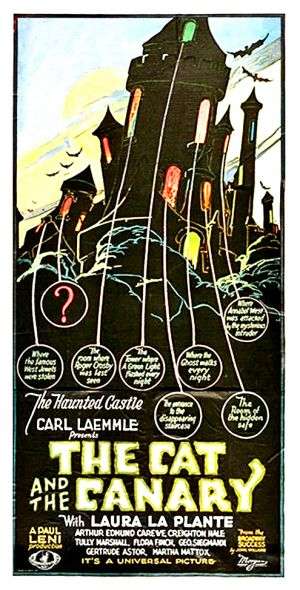The Cat and the Canary

The Cat and the Canary is a stage play by John Willard from 1922.
Its plot concerns the inheritance of Cyrus West, an eccentric old man with much contempt towards his relatives and who decreed that his will is to be read in his mansion twenty years after his death, at midnight with all his living relatives present.
Twenty years later, on a dark and stormy night, six of his relatives arrive at the mansion to hear out the will. The old family lawyer opens the envelope containing the will and it is written that Cyrus' fortune goes to his most distant relative with the surname of West, who happens to be Annabelle. Only On One Condition though; she must be deemed sane, as Cyrus felt that his relatives were insane like he was during his last days. If she fails to fulfill this condition, the fortune goes to Cyrus' second most distant relative, named in another letter.
This is a start for one very long night, as an Ax Crazy mental patient who slashes at his victims like a cat is stalking the West mansion grounds, and Annabelle's sanity is put into question after the lawyer suddenly vanishes.
The play has been adapted into several movies, notable ones being the 1927 silent film (which was one of the earliest Universal Horror movies), 1930 sound remake of the latter titled The Cat Creeps and its Spanish version La Voluntad del Muerto (both are now unfortunately lost) and the 1939 version starring Bob Hope.
- Closed Circle: Nobody is allowed to leave the house -- supposedly.
- Creepy Housekeeper: Mammy Pleasant.
- Cut Phone Lines
- Fainting: Annabelle, twice -- first after being molested by the hand, the second time after discovering the corpse.
- Fangs Are Evil
- For Doom the Bell Tolls
- His Name Is--: When Crosby attempts to tell Annabelle the name of the other possible inheritor, he is dragged inside the Bookcase Passage.
- Hand of Death
- I Will Definitely Protect You
- The Noun and the Noun
- Old Dark House
- On One Condition
- Peek-a-Boo Corpse
- The Shrink: Doctor Patterson arrives at the house to examine Annabelle.
- Title Drop
- When the Clock Strikes Twelve: That's when the Will is read.
The 1927 film features:
- Accidental Pervert: Paul when he in a state of panic (he thought he saw a ghost) hides under the bed in the room of aunt Susan and her daughter Cecilly and catches glimpses of them undressing.
- All in the Eyes: Used on Paul when Susan finds him under her bed.
- Big Ol' Unibrow: Guard.
- Color Wash: One version has different colour schemes for certain moods: Lighted indoor scenes are sepia tone, moments in the dark are dark blue and the horror moments are red.
- Femme Fatalons: In a fake-out, a clawed hand reaching across a couch is revealed not to belong to the monster.
- The Glasses Come Off: And shit goes down.
- Hostile Weather
- Mad Eye
- Madness Montage: Shown in the opening where Cyrus literally sees cats descending as if he was a canary.
- Nerd Glasses: Paul.
- Rule of Symbolism: Cyrus West sees his relatives as "cats circling around the canary".
- Say My Name
- Secret Path: The house is filled with secret stashes and paths.
- Symbol Swearing: Susan's swearing when she sees that it was Paul under her bed.
- Took a Level in Badass
Other versions have:
- The Big Easy: 1939 film.
- Video Wills: In the 1979 version.